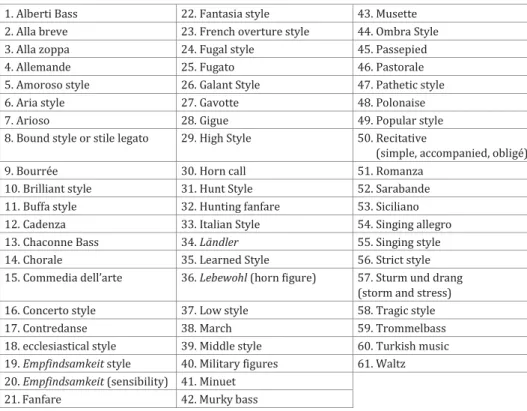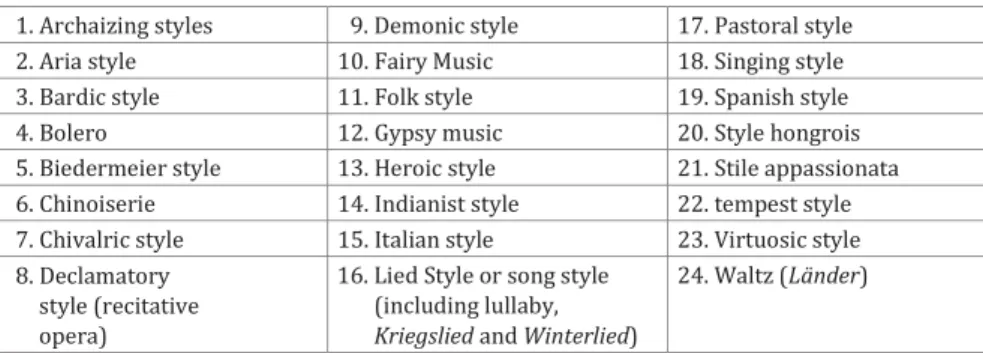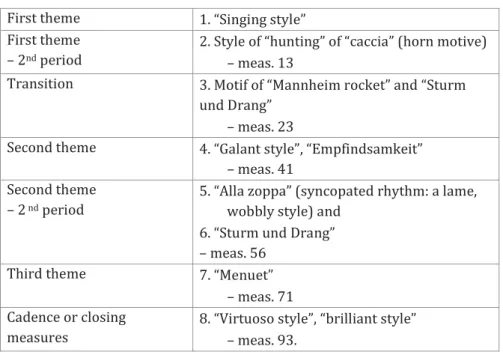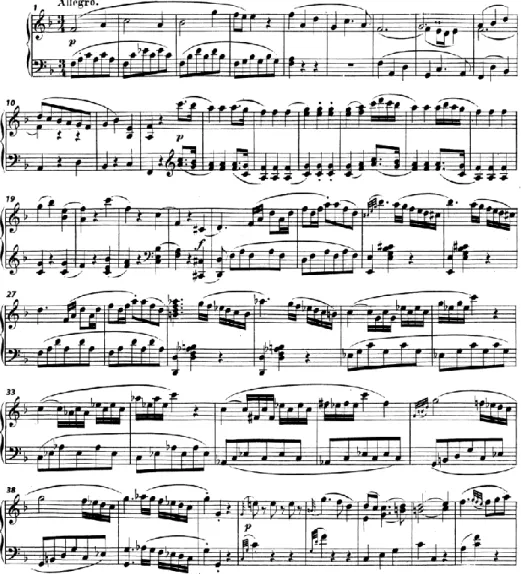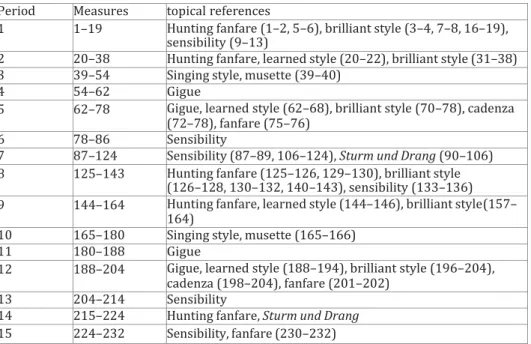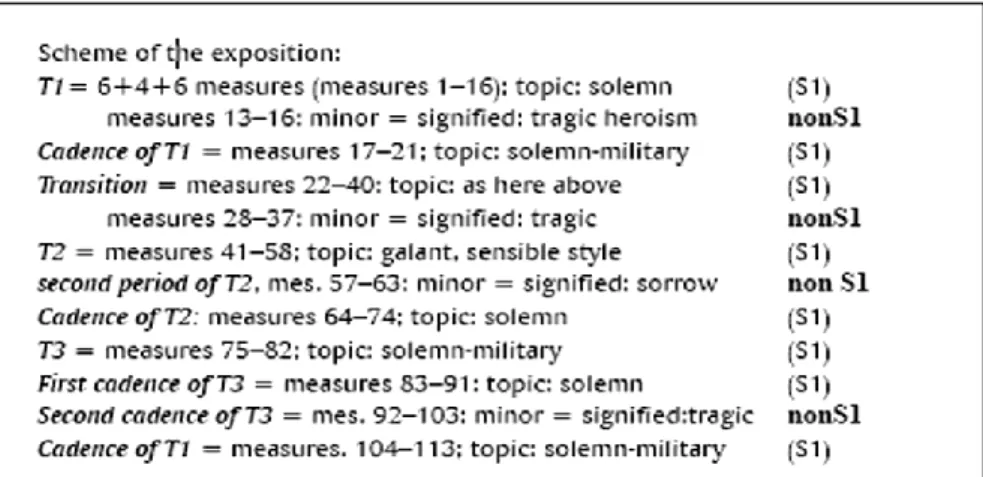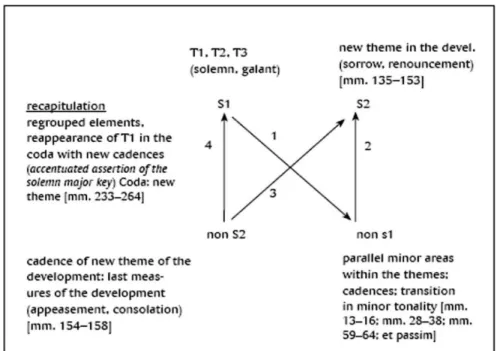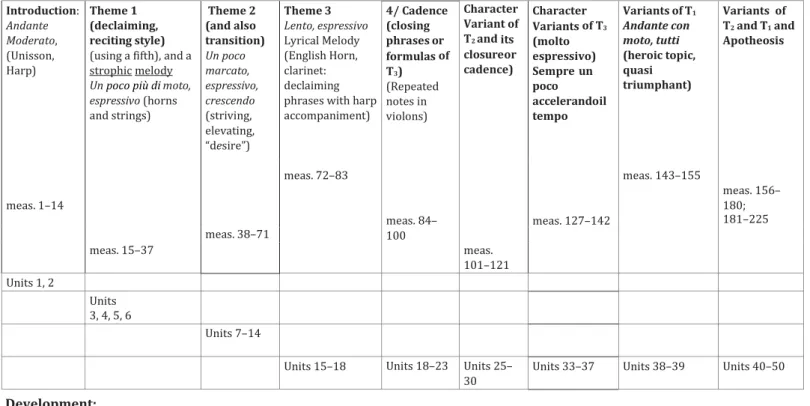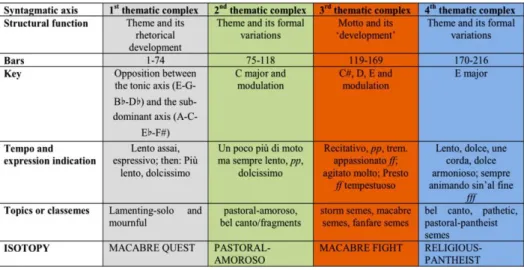Márta Grabócz
UNIVERSITY OF STRASBOURG –IUF,FRANCE e-mail: grabocz@club-internet.fr, grabocz@unistra.fr
Musical semiotics today: Theories of the signified and examples of narrative
strategies
key words: musical semiotics, narrative strategies, topics
Since the 1970s, we have observed major changes in the field of musicology: books by Charles Rosen (1971), Jean-Jacques Nattiez (1975), Gino Stefani (1976), Eero Tarasti (1978) and Joseph Kerman (1985) marked the first decisive step towards the renewal of musical analysis through the study of signification and meaning, as well as via semiotics and narration. After 1986, a second wave of musicological analyses – by Karbusicky, Tarasti, Agawu, Monelle, Hatten, Nattiez, Abbate, Miereanu, and Lidov, as well as, from 1995 on, in papers delivered at the ICMS congresses (No. 1 to No. 12) – clearly shows that music scholars are now in search of new models to describe the complex dynamic process underlying musical form1.
Since circa 2005 some exponents of musical semiotics in English- speaking countries have begun to focus on two fields:
1. one the one hand, topic theory (for example, articles and books
1 In an article published in Wroclaw in 2015, I addressed other aspects of current musical semiotic trends: “An Introduction to theories and Practice of Musical Signification and Narratology”.
by Kofi Agawu, Raymond Monelle, Nicholas McKay, William caplin, Robert Hatten, and Danuta Mirka as editor, etc.), and, on the other
2. the relationship between musical form and topical structure (Agawu, Caplin, Monelle, Tarasti, Grabócz, M. Klein, etc.).
I. Signifieds as topics or intonations
The above-mentioned contemporary musicologists have pointed out that traditional musicology focused on developing the means to describe the “signifier”, i.e. the structure, but ignored the “signified” altogether.
Nowadays, the terminology is more varied so as to reflect different geographical regions, and diversified to define signifying units. In the 1960s and 1970s, Eastern and Central European musicologists (such as Jiránek, Ujfalussy, Karbusicky, Maróthy) employed the term “intonation”. To discuss
“the irreducible character of music’s symbolic negotiations with the world’s cultural units”2both American and Anglo-Saxon musicologists resorted to 18th-19th century categories, as formulated by Koch, Marpurg, Mattheson, A.B. Marx, and called them “topics” (see: Ratner, Hatten, Tarasti, Agawu, etc.).
Between 1996 and 2010, Raymond Monelle extended this field of research to other periods. In his article on “Textual semiotics in music”
(1998), he defined the signified, after Peirce, as “indexicalities of style, of temporality and subjectivity”, and/or as “symbols” (note how they corresponded with the notion of ‘topic’). Vladimir Karbusicky’s 1990 study shows that he, too, applied the three Peircean categories (icon, index, symbol) to his analysis of the signified in music. In his 1991 monograph, Kofi Agawu spoke of topic signs ans structural signs (“introspective/introspective” and “extrospective/extrospective” semiosis) in classical music. For him, the complex description and interpretation of a musical form is assured by the interplay, the interaction between these two types of topics and analyses (or semiosis)3. (Agawu, 1991). In his 2008 monograph, Agawu analyses romantic movements and forms from a new point of view. Other musicologists (Tarasti, Monelle, Hauer, Esclapez, etc.) inspired by Greimassian semiotics applied such categories as seme, classeme, and isotopy to describe the signifieds.
Despite their different sources, one thing these definitions of signifying
2 Robert Hatten, “Grounding Interpretation: A Semiotic Framework for Musical Hermeneutics”, in: Signs in Musical Hermeneutics. The American Journal of Semiotics 13, 1998 No. 1–4, ed. by Siglind Bruhn, p. 24.
3 Kofi Agawu, Playing with Signs. A Semiotic Interpretation of Classic Music, Princeton University Press, Princeton 1991.
units have in common, is that they all refer to historical musical genres and styles. These ancient genres, thanks to their function embedded in the life of collectivities, can recreate links – due to their methods of stylization – with the cultural units of each historical epoch. They are the signs, the emotional, stylistic, gestural, visual, historical references that can generate signification or sense in music.
In my presentation, I shall focus on current English-American theory and also, in part, on my own analyses. However, to begin with, I shall present a number of definitions of topic and intonations given by different authors.
In 1968, József Ujfalussy borrowed the term “intonation” from vocal music, i.e. from the traditional interpretation of music which has sought within this art form to link attitudes and human feelings to the intonations of the spoken language since antiquity.
In the actual practice of musical aesthetics, however, the category of intonation represents much more than the simple melodic and rhythmic intonation of the inflections of spoken language. In real terms, intonation signifies formulas, types of specific musical sonorities which transmit a human and social meaning represented by the characters set out in the entire composition4.
In 1980 Leonard Ratner offered the following definition of “topic”:
From its contacts with worship, poetry, drama, entertainment, dance, ceremony, the military, the hunt, and the life of the lower classes, music in the early 18th century developed a thesaurus of characteristic figures, which formed a rich legacy for classic composers. Some of these figures were associated with various feelings and affections; others had a picturesque flavor. they are designated here as topics – subjects for musical discourse5.
In the 1980s the Finnish musicologist Eero Tarasti considered the concept of “intonation” to be the basis of the musical sign.
Although Assafiev regarded composition as an item endowed with sound provided with intonation, he equally understood that the existence of music persisted in the collective musical memory of listeners. this musical awareness, a sort of virtual reservoir, is born and develops from some particularly impressive passages, to be
4 József Ujfalussy, Az esztétika alapjai és a zene [Foundations of Aesthetics and the Music], Tankönyvkiadó, Budapest 1978.
5 Leonard Ratner, Classic Music, Éditions Schirmer, New York 1980.
found in any composition, which Assafiev refers to as memoranda6. Later, in 2007, Raymond Monelle contended that
we now understand that topics may be fragments of melody, of rhythm, styles, conventional forms, aspects of timbre of harmony, which denote items of social or cultural life, and through them expressive themes such as manliness, the outdoors, innocence, the lament. The nexus between musical element and signification is by means of correlation7.
In 2014 Kofi Agawu listed the largest number of such topics, which he divided into several categories according to different artistic periods and relevant authors: classic topics, romantic topics and topics of the 20th century, etc. (see figures 1-5).
1. Alberti Bass 22. Fantasia style 43. Musette
2. Alla breve 23. French overture style 44. Ombra Style
3. Alla zoppa 24. Fugal style 45. Passepied
4. Allemande 25. Fugato 46. Pastorale
5. Amoroso style 26. Galant Style 47. Pathetic style
6. Aria style 27. Gavotte 48. Polonaise
7. Arioso 28. Gigue 49. Popular style
8. Bound style or stile legato 29. High Style 50. Recitative
(simple, accompanied, obligé)
9. Bourrée 30. Horn call 51. Romanza
10. Brilliant style 31. Hunt Style 52. Sarabande
11. Buffa style 32. Hunting fanfare 53. Siciliano
12. Cadenza 33. Italian Style 54. Singing allegro
13. Chaconne Bass 34. Ländler 55. Singing style
14. Chorale 35. Learned Style 56. Strict style
15. Commedia dell’arte 36. Lebewohl (horn figure) 57. Sturm und drang (storm and stress)
16. Concerto style 37. Low style 58. Tragic style
17. Contredanse 38. March 59. Trommelbass
18. ecclesiastical style 39. Middle style 60. Turkish music 19. Empfindsamkeit style 40. Military figures 61. Waltz 20. Empfindsamkeit (sensibility) 41. Minuet
21. Fanfare 42. Murky bass
Figure 1. Agawu: list of classic topics, by Leonard Ratner
6 Algirdas Julien Greimas et Joseph Courtés, Sémiotique: Dictionnaire raisonné de la théorie du langage, Éditions Hachette, Paris 1983, p. 124.
7 Raymond Monelle, “Sur quelques aspects de la théorie des topoi musicaux”, in: Sens et signification en musique, ed. by Márta Grabócz, Éditions Hermann, Paris 2007, p. 177–193.
1. Archaizing styles 9. Demonic style 17. Pastoral style
2. Aria style 10. Fairy Music 18. Singing style
3. Bardic style 11. Folk style 19. Spanish style
4. Bolero 12. Gypsy music 20. Style hongrois
5. Biedermeier style 13. Heroic style 21. Stile appassionata 6. Chinoiserie 14. Indianist style 22. tempest style 7. Chivalric style 15. Italian style 23. Virtuosic style 8. Declamatory
style (recitative opera)
16. Lied Style or song style (including lullaby, Kriegslied and Winterlied)
24. Waltz (Länder)
Figure 2. Romantic topics, after Janice Dickensheets (2003) 1. Appassionato, agitato 9. Bel canto, declamatory
2. March 10. Recitativo
3. Heroic 11. Lamenting, elegiac
4. Scherzo 12. Citations
5. Pastoral 13. The grandioso, triumfando (going back to the heroic theme) 6. Religioso 14. The lugubrious type, derived at the same time
from appassionato and lament (lacrimoso) 7. Folkloric 15. The pathetic, which is an exalted form of bel canto 8. Bel canto, singing 16. The pantheistic, an amplified variant of either the pastoral
theme or the religious type
Figure 3. Agawu: topics in Liszt according to Grabócz (1986)
1. Nature theme 7. March
(including funeral march) 13. Bell motif
2. Fanfare 8. Arioso 14. Totentanz
3. Horn call 9. Aria 15. Lament
4. Bird call 10. Minuet 16. Ländler
5. Chorale 11. Recitativo 17. March
6. Pastorale 12. Scherzo 18. Folk Song
Figure 4. Agawu: 19th century topics, Mahler, after Floros
Group A Group B Group C
1. Menuet 11. Jewish music 21. Gregorian chant 31. Cafe music
2. Gavotte 12. Czech music 22. Chorale 32. Circus Music
3. Bourrée 13. Polish music 23. Russian orthodox
church style 33. Barrel organ 4. Sarabande 14. Hungarian music 24. Learned style 34. Lullaby
5. Gigue 15. Gypsy music 25. Chaconne 35. Children’s song
6. Pavane 16. Russian music 26. Recitativo 36. Fanfare 7. Passepied 17. Spanish music 27. Singing style 37. Military march
8. Tarentella 18. Latin-American music (Brazilian, Argentinean, Mexican)
28. Barcarole 38. Funeral march
9. Tango 19. “Oriental” music (chinese,
Japanese, Indian) 29. Negro spirituals 39. Pastoral style 10. Waltz 20. North American country
music 30. Jazz 40. Elegy
41. Machine music
Figure 5. Agawu: 20th century topics, according to Mirka
In 2014, Danuta Mirka edited The Oxford Handbook of Topic Theory8, a very important volume considered to be the ultimate book on topic theory, comprising the chapters below arranged into the following three sections:
I) Origins and Distinctions, II) contexts, Histories and Sources, and III) Analyzing Topics.
8The Oxford Handbook of Topic Theory, Danuta Mirka (ed.), Editions Oxford University Press, Oxford, 2014
SECTION I ORIGINS AND DISTINCTIONS
1. Topics and Opera Buffa
Mary HUNTER 61
2. Symphonies and the Public display of topics
Elaine SISMAN 90
3. Topics in chamber Music
W. Dean SUTCLIFFE 118
SECTION II CONTEXTS, HISTORIES, SOURCES
4. Music and dance in the Ancien Régime
Lawrence M. ZBIKOWSKI 143
5. Ballroom dances of the Late eighteenth century
Eric MCKEE 164
6. Hunt, Military, and Pastoral topics
Andrew HARINGER 194
7. Turkish and Hungarian-gypsy Style
Catherine MAYES 214
8. The Singing Style
Sarah DAY-O’CONNELL 238
9. Fantasia and Sensibility
Matthew HEAD 259
10. Ombra and Tempesta
Clive MCCLELLAND 279
11. Learned Style and Learned Styles
Keith CHAPIN 301
12. the Brilliant Style
Roman IVANOVITCH 330
SECTION III ANALYZING TOPICS
13. Topics and Meter
Danuta MIRKA 357
14. Topics and Harmonic Schemata: A case from Beethoven
Vasili BYROS 381
15. Topics and Formal Functions:
The Case of the Lament
William E. CAPLIN 415
16. Topics and Tonal Processes
Joel GALAND 453
17. Topics and Form in Mozart’s String Quintet in E Flat Major, K 914/i
Kofi AGAWU 474
18. Topical Figurae: The Double Articulation of topics
Stephen RUMPH 493
19. The Troping of Topics in Mozart’s Instrumental Works
Robert S. HATTEN 514
Figure 6. Some chapters on topics in The Oxford Handbook of Topic Theory, ed. by D. Mirka, 2014
II. Form and topics in the classical period
In the second stage we can examine the strategies employed to organize topics according to the classical period.
As a first musical example, let us take a look at the sequence of topics in Mozart’s Sonata in F Major K. 332. In the exposition, we recognize eight
different topics which reveal a very exceptional structure9(fig. 7).
First theme 1. “Singing style”
First theme – 2nd period
2. Style of “hunting” of “caccia” (horn motive) – meas. 13
Transition 3. Motif of “Mannheim rocket” and “Sturm und Drang”
– meas. 23
Second theme 4. “Galant style”, “Empfindsamkeit”
– meas. 41 Second theme
– 2 nd period
5. “Alla zoppa” (syncopated rhythm: a lame, wobbly style) and
6. “Sturm und Drang”
– meas. 56
Third theme 7. “Menuet”
– meas. 71 Cadence or closing
measures
8. “Virtuoso style”, “brilliant style”
– meas. 93.
Figure 7. Exposition table (form and topics), Mozart Sonata in F Major, K. 332 first movement
9 The standard sonata exposition (in major tonality) uses 2-3 topics, all belonging to the same topical sphere: heroic or solemn followed by the galant and /or singing style, etc.
Figure 8. First part of the exposition (Mozart, Sonata in F Major, K. 332, first movement), measures 1–45, Edition Peters, Leipzig No. 18000b
We will now take a look at an example of form analyses based on topic theory from Agawu’s article in The Oxford Handbook of Topic Theory entitled “topics and Form in Mozart’s String Quartet in E Flat Major K. 614/I”10.
First, Agawu describes the paradigmatic form of the first movement in
10 Kofi Agawu, “Topics and Form in Mozart’s String Quintet in E Flat Major, K. 614/I”, in: The Oxford Handbook of Topic Theory, op. cit., p. 474–492.
fifteen musical periods. In the scheme (figure 9) we observe six columns, which means that there are six different themes, motives and topics in the movement.
1 2 3 4
5 6 7
8 9 10 11
12 13
14 15
Figure 9. The paradigmatic structure of the Mozart’s Quintet K. 614 by Agawu In the second step, he provides a scheme of topical references corresponding to the fifteen sections, without any hierarchy. Thirdly, in his article, he describes the fifteen sections (figure 10).
Period Measures topical references
1 1–19 Hunting fanfare (1–2, 5–6), brilliant style (3–4, 7–8, 16–19), sensibility (9–13)
2 20–38 Hunting fanfare, learned style (20–22), brilliant style (31–38) 3 39–54 Singing style, musette (39–40)
4 54–62 Gigue
5 62–78 Gigue, learned style (62–68), brilliant style (70–78), cadenza (72–78), fanfare (75–76)
6 78–86 Sensibility
7 87–124 Sensibility (87–89, 106–124), Sturm und Drang (90–106) 8 125–143 Hunting fanfare (125–126, 129–130), brilliant style
(126–128, 130–132, 140–143), sensibility (133–136) 9 144–164 Hunting fanfare, learned style (144–146), brilliant style (157–
164)
10 165–180 Singing style, musette (165–166)
11 180–188 Gigue
12 188–204 Gigue, learned style (188–194), brilliant style (196–204), cadenza (198–204), fanfare (201–202)
13 204–214 Sensibility
14 215–224 Hunting fanfare, Sturm und Drang 15 224–232 Sensibility, fanfare (230–232)
Figure 10. Agawu’s topical references in Mozart’s String Quintet in E flat major K. 614, with annotations from Grabócz.
We can complete the scheme with formal indications: Exposition, Themes, Development, Recapitulation, and Coda. With the help of this supplement, we can see that the main theme and the transition correspond to a “Hunting Fanfare”, but the Second Theme represents the “singing style”, and the third theme a “gigue”. the development exploits the “Sturm und
Drang” and “Hunting Fanfare” topics and the recapitulation corresponds to the exposition. However, the coda reiterates the “Sturm und Drang” topic and thus amplifies the expressive device.
Form Period themes Measures Topical references
Exposition 1 T1 1–19 Hunting fanfare (1–2, 5–6), brilliant style (3–4, 7–8, 16–19), sensibility (9–
13)
2 Transition 20–38 Hunting fanfare, learned style (20–22), brilliant style (31–38)
3 T2 39–54 Singing style, musette (39–40)
4 54–62 Gigue
5 T3 62–78 Gigue, learned style (62–68), brilliant style (70–78), cadenza (72–78), fanfare (75–76)
6 Closing 78–86 Sensibility Development 7 T1 and new
topic 87–124 Sensibility (87–89, 106–124), Sturm und Drang (90–106)
8 125–143 Hunting fanfare (125–126, 129–130), brilliant style (126–128, 130–132, 140–143), sensibility (133–136) Recapitulation 9 T1 144–164 Hunting fanfare, learned style (144–
146), brilliant style (157–164) 10 T2 165–180 Singing style, musette (165–166)
11 T3 180–188 Gigue
12 188–204 Gigue, learned style (188–194), brilliant style (196–204), cadenza (198–204), fanfare (201–202) 13 Closing 204–214 Sensibility
Coda 14 Coda with 3 215–224 Hunting fanfare, Sturm und Drang 15 Topics 224–232 Sensibility, fanfare (230–232) Figure 11. Mozart, String Quintet in E flat major K. 614, first movement: 15 sections,
form indications and topics (with form annotations by Grabócz)
Since 1996, I have tried to examine a number of sonata forms of the classic style which display more than a linear succession of standard topical or narrative functions. thanks to the freedom allowed by the technique of development up to the middle section of a sonata form, we are sometimes dealing with a logical sequence (i.e. a chain or succession) of four different topical stages arranged as paired contradictory terms (see the semiotic square of Greimas11, figure 12).
11 A.J Greimas and Joseph Courtés, Sémiotique: Dictionnaire raisonné de la théorie du langage, Éditions Hachette, Paris 1979 (1983); English translation: Semiotics and Language. An Analytical Dictionary, Bloomington, Indiana University Press 1982, p. 308–312.
Figure 12. Greimas’s semiotic square displaying paired contradictory terms (with the relations of contradiction, contrariety, and complementarity; and involving such
operations as presupposition, negation, and assertion)
These rare dramatic structures, capable of inducing catharsis. they can be found in some of the great symphonic and piano movements of Mozart and Beethoven. By applying Greimas’s narrative semiotics and structural semantics to these dramatic sonata forms, we can easily discover paired contradictory terms (binary oppositions), correlated one with another so as to resolve a conflict or problem.
I tried to demonstrate (2009) how this cathartic structure of the signified operates, for example, in the first movement of Mozart’s Symphony in C-major K. 338. Here four different topics are placed in correlation. the exposition presents the conflict between the solemn topic (admiration, festivity, galant style: S1) and that of its negation as the topic of tragic heroism, i.e. the topic of the hero in despair, as called forth by the key of the minor tonality within the first theme (see fig. 13: measures or sections called non S1).
Figure 13. Mozart, Symphony in C major K. 338, mvt. I – Exposition. (Marked in bold: non S1 – measures in minor key, as a negation or opposite of the precedent
topic)
The middle section of the movement (development) presents a new
theme, which introduces the third affect: sorrow, renunciation, and lamentation: S2 (see fig. 15).
The recapitulation of the movement regroups the two opposing (or conflicting) signifieds of the exposition in a new and unexpected manner.
Here, elements of S1 and non-S1 are situated, and even confronted in a grouped or assembled manner, accentuating the conflict and the plot between the solemn-majestic-galant topic and that of complaints and tragic heroism (see Fig. 14).
Figure 14. Mozart, Symphony in C major K. 338, mvt. I – Recapitulation – topical scheme. (The section non S1 brings together in the middle part of the recapitulation all the elements of negation, elements in minor keys. At the end, the
topic of S1 will be reaffirmed, renewed and completed.)
This stressed opposition of topics in the recapitulation requires an univoqual dénouement in the coda. In this historical period of music, the
composer of classic music is obliged to reaffirm the euphoric topics as outcome. Mozart creates a coda in which he reintroduces the first solemn theme in all its splendor (completed by a new cadence), with the aim of dissipating the conflicts of the intrigue and to bring about a positive solution.
Representation of the whole movement, using Greimas’s semiotic square, describes a topical trajectory consisting of four stages corresponding to a succession of paired contradictory terms. this scheme of the semantic square shows the cathartic creation of new “value objects” throughout the movement – an exceptional strategy within the framework of the ABA sonata form (see Fig. 15: here the numbers describe the four successive steps of the narrative trajectory, using paired contradictory terms: S1–
nonS1 – S2 – non S2 – and a return to modified S1, i.e. a renewed first Theme at the end of the movement).
Figure 15. Mozart, Symphony in C major, K. 338, global form with a presentation of the paired oppositions of the four topics: S1 = Solemn and galant; non S1 = tragic heroism or despair; S2 = a new theme of sorrow or complaint in the development;
non S2 = appeasement, consolation in the recapitulation; modified S1: a new version of the solemn Theme 1 in the coda)
III. Form and Topics in the Romantic era
In this chapter I would like to present two different ways of describing the topical structure in the nineteenth century, particularly in Liszt’s works.
In his 2009 monograph on Music as Discourse, Kofi Agawu introduces several analyses of nineteenth-century music, including that of the symphonic poem of Liszt’s Orpheus12. Agawu first gives a synoptic view of the piece, that is a paradigmatic form in 50 units or building blocks, where the columns (of the horizontal structure) indicate the appearance of a new thematic or motivic unit, and the vertical structure indicates the repetition (varied or not) of a given unit (see figure 16). He then describes all the 50 sections, called units or building blocks13.
1
2 3
4 5
6 7
8 9 10 11 12 13
14 15 16 17 18
19
20 21
22
23 24
25 26 27 28
29
30 31
32 34 33
35 36 37 38 39 40
41 42
43 44
45 46 47
48
49 50
12 Kofi Agawu, Music as Discourse: Semiotic Adventures in Romantic Music, Oxford University Press, New York 2009, p. 211–228.
13 Ibidem, p. 211–220.
Figure 16. Paradigmatic chart of all 50 units of Liszt’s Orpheus according to Agawu14 In the following chapters of his article, Kofi Agawu introduces a number of hypotheses regarding form15. By discussing the confrontation of Liszt’s new form with the sonata form, he also refers to the analyses of Richard Kaplan and Rainer Kleinertz.
In a supplementary figure (No. 17), I present the same structure completed with formal functions, tempo and other indications of Liszt, according to measures, expressions or topic descriptions.
Using figure No. 17 as our basis, we can hypothesise that after the harp unison introduction, we are listening to the first theme with fifth intervals, and strophic declamation. The second theme presents the topic of
“striving” or “desire” elevated by chromatic motifs in the strings; the third theme is more lyrical, indicating “lento espressivo”, with a harp accompaniment, corresponding to the theme of Eurydice. The last new motivic element (No. 4) employs note repetition in a strophic manner, and resembles a cadence, a closure of the last 3rd theme. If we continue to describe the sections until the end, we will recognize that with the help of
“character variations”, certain themes are provided with new topics, new significations, and the expressive structure changes throughout the entire piece. (See the second part marked in grey in the diagram). For example:
in the final part of the piece, units 33–43, we recognize the character variations of the third theme and the main theme (T1), which become heroic, changing the declamatory rhetoric style of the beginning. After the great apotheosis of the second and third themes, the theme of Eurydice undergoes an important metamorphosis: it indicates the non-human word, Apotheosis in the transcendent universe (see figure 17).
Since 1986, I have published several topical analyses of Liszt’s piano works16. For example, an analysis of the Vallée d’Obermann can be organized with the help of the following diagram (fig. 18):
14 Ibidem, p. 221.
15 Ibidem, p. 220–227.
16 Márta Grabócz, Morphologie des oeuvres pour piano de Franz Liszt, MtA Zenetudomŕnyi Intézet, Budapest 1986, new revised edition: Kimé, Paris 1996; eadem, Musique, narrativité, signification, L’Harmattan, Paris 2009; eadem, “Two Faces of the «mal du siècle» in Literature of the 19th century and in the Music of Liszt”, in: Studia Musicologica Academicae Hungaricae (55/1) 2014 No. 1–2, p. 43–64; eadem, “Narrative Strategies of the Romantic «philosophical epics» in the Piano Works of Franz Liszt. (Analysis of Spozalizio, Vallée d’Obermann, Ballade N°2 and the Sonata in B minor)”, in:
Interdisciplinary Studies in Musicology No. 14, ed. by Maciej Jablonski, Ewa Schreiber, Jakub Kasperski, Poznan 2014, p. 113–135.
Introduction:
Andante Moderato, (Unisson, Harp)
Theme 1 (declaiming, reciting style) (using a fifth), and a strophic melody Un poco più di moto, espressivo (horns and strings)
Theme 2 (and also transition) Un poco marcato, espressivo, crescendo (striving, elevating,
“desire”)
Theme 3 Lento, espressivo Lyrical Melody (English Horn, clarinet:
declaiming phrases with harp accompaniment)
4/ Cadence (closing phrases or formulas of T3) (Repeated notes in violons)
meas. 84–
100
Character Variant of T2 and its closure or cadence)
Character Variants of T3
(molto espressivo) Sempre un poco accelerando il tempo
meas. 127–142
Variants of T1
Andante con moto, tutti (heroic topic, quasi triumphant)
Variants of T2 and T1 and Apotheosis
meas. 1–14
meas. 72–83 meas. 143–155
meas. 156–
180;
181–225 meas. 38–71
meas. 15–37 meas.
101–121 Units 1, 2
Units 3, 4, 5, 6
Units 7–14
Units 15–18 Units 18–23 Units 25–
30
Units 33–37 Units 38–39 Units 40–50
Development:
Sections 34–43 (T2) – character variations Culminating Point: Sections: 44–46 (T2 –T3)
Coda: sections 47–50 (Metamorphosis of the Themes 2,1) – Character variations: Apotheosis
Figure 17. Liszt: Orpheus, a formal analysis (by M. Grabócz) with an apparition of the 50 units or building blocks of Kofi Agawu
Figure 18. Narrative structure of Liszt’s Vallée d’Obermann: a monothematic piece, offering a succession of four topics: 1) lamentation or macabre quest (grey);
2) pastoral – amoroso variant (green); 3) a “tempest” scene or macabre fight as a variant (orange); 4) a religious-pantheist answer/variant as culmination (blue).
Figure No. 18 presents a simple narrative strategy based on one theme (in a monothematic piece, its duration is about 14 minutes) with four thematic complexes (or units, sections) corresponding to four topics or isotopies: 1) topic of lament or “macabre quest”, 2) topic of “pastoral- amoroso”, 3) topic of “tempestuoso” or “macabre fight” and 4) topic of
“religioso”.
By analyzing many of Liszt’s other piano works (as well as symphonic poems), we can observe that a great number of Liszt’s instrumental works involve the same succession of topics, which combine to form a ‘canonical narrative structure’ with a fixed concatenation of topics or expressive genres (figure 19).
According to this strategy, the internal narrative programme of Liszt comprises four stages in the concatenation of topics:
1) Topic of Lament: a gloomy quest or state of spleen, or the Faustian question about the meaning of existence, etc. (possible indications in the scores: ‘avec un profond sentiment de l’ennui’, Andante lagrimoso, con duolo, languendo, lamentoso lagrimoso, lento e espressivo, Andante lagrimoso, sotto voce).
2) Topic of pastoral-amoroso answer or response found in love and intimacy (con intimo sentimento, dolcissimo, una corda, con amore).
Figure 19. The canonical succession of four topics observed in several works by F. Liszt. (Here the Vallée d’ Obermann serves as a model.)
3) The previous answer or response is annulled, followed by a second answer or response provided by the image of tempest or of struggle, a fight against an imaginary external or internal world; see the musical images of storm or battle fanfares (tempestuoso, recitativo, espressivo; molto energico e marcato); this answer or response is once again canceled at the end of the section.
4) The third answer or response found in faith and religion, and especially in transcendental pantheism (choral texture, modal or pentatonic melodic/harmonic structure, arpeggiated accompaniment imitating chimes, church bells, etc.). Indications in the score:
dolcissimo e armonioso; cantabile assai; dolce armonioso; tre corde;
tremolando, campanella).
Coda: reiterated macabre questions.
This compositional strategy, as revealed through the juxtaposition of topics, outlines a journey, a wandering or an initiation which leads from a macabre, anxious and lugubrious interrogation to a certain serenity found in religious or pastoral feelings, finding consolation through nature, pantheism or transcendence.
***
I would like to conclude these presentations by linking the formal and topical examination of a number of musical pieces, and by underlining the fact that this type of complex analysis can serve as a platform for comparing works within the same style (such as classic music, for example), or within the oeuvre of a single composer (as in the works of Liszt, i.e.), on the one hand, and it enables us to establish correlations or comparisons between music and other arts in the same historical period. In other words: the descriptive and logical models provided by literary narratology and applied to musical analysis shed light on the internal functioning and evolution of a particular musical style, but also enhance our ability to compare different musical styles. There is also scope for developing a method for interdisciplinary analysis.
References
Abbate Carolyn, Unsung Voices. Opera and Musical Narrative in the Nineteenth Century, Princeton University Press, Princeton 1991.
Agawu Kofi, Playing with Signs. A Semiotic Interpretation of Classic Music, Princeton University Press, Princeton 1991.
Agawu Kofi, Music as Discourse: Semiotic Adventures in Romantic Music, Oxford University Press, New York 2009.
Agawu Kofi, “Topics and Form in Mozart’s String Quintet in E Flat Major, K. 614/I”, in: The Oxford Handbook of Topic Theory, ed. by Danuta Mirka, OUP, New York 2014, p. 474–492.
Assafiev Boris, Die musikalische Form als Prozess, Verlag Neue Musik, Berlin 1976. Caplin William E., “On the relation of musical topoi to formal function”, Eighteenth Century Music (vol. 2) 2005 No. 1, p. 113–124.
Esclapez Christine (ed.), Ontologies de la création en musique, Des actes en musique, editions L’Harmattan, Paris 2012.
Gino Stefani, Introduzione alla Semiotica della Musica, Sellerio, Palermo 1976. Grabócz Márta, Morphologie des oeuvres pour piano de Franz Liszt, MtA Zenetudomŕnyi Intézet, Budapest 1986, new revised edition: Kimé, Paris 1996.
Grabócz Márta, Musique, narrativité, signification, L’Harmattan, Paris 2009.
Grabócz Márta, “An Introduction to theories and Practice of Musical Signification and Narratology”, in: Analiza dzieła muzycznego.
Musica Analyses. Historia, Theoria, Praxis, ed. by Anna Granat- Janki, Akademia Muzyczna im. Karola Lipińskiego, Wrocław 2016, article in Polish: pages 25–43 [Wprowadzenie do teorii i praktyki znaczenia muzycznego i narratologii], article in English:
pages 325–341.
Grabócz Márta, “Two Faces of the «mal du siècle» in Literature of the 19th century and in the Music of Liszt”, in: Studia Musicologica Academicae Hungaricae (55/1) 2014 No. 1–2, p. 43–64.
Grabócz Márta, “Narrative Strategies of the Romantic ‘philosophical epics’ in the Piano Works of Franz Liszt (Analysis of Spozalizio, Vallée d’Obermann, Ballade N°2 and the Sonata in B minor)”, in:
Interdisciplinary Studies in Musicology (14), ed. by Maciej Jabłoński, Ewa Schreiber, Jakub Kasperski, Poznań 2014, p. 113–
135.
Greimas Algirdas Julien & Courtés Joseph, Sémiotique: Dictionnaire
raisonné de la théorie du langage, Éditions Hachette, Paris 1979 (1983); English translation: Semiotics and Language. An Analytical Dictionary, Indiana University Press, Bloomington 1982.
Hauer Christian, “Une herméneutique de la création et de la réception musicales”, in: Sens et signification en musique, ed. by Márta Grabócz, Hermann Éditeurs, Paris 2007, p. 123–132.
Hatten Robert, “Grounding Interpretation: A Semiotic Framework for Musical Hermeneutics”, in: Signs in Musical Hermeneutics. The American Journal of Semiotics 13, ed. by Siglind Bruhn, 1998 No.
1–4, p. 25–42 (special issue).
Hatten Robert, Interpreting Musical Gestures, Topics, and Tropes, Indiana University Press, Bloomington 2004.
Hatten Robert, Musical Meaning in Beethoven. Markedness, Correlation, an Interpretation, Indiana University Press, Bloomington 1994.
Hjelmslev Louis, Prolégomènes à une théorie du langage, Éditions de Minuit, Paris 1971 (1943).
Jiránek Jaroslav, “Intonation as a specific form of musical semiosis”, in:
Musical Signification. Essays in the Semiotic Theory and Analysis of Music [IcMS 1], ed. by Eero tarasti, Mouton de Gruyter, Berlin/New York 1995, p. 155–188.
Jiránek Jaroslav, Zu Grundfragen der musikalischen Semiotik, Verlag Neue Musik, Berlin 1985.
Karbusicky Vladimir, Grundriss der musikalischen Semantik, Wissenschaftliche Buchgesellschaft, Darmstadt 1986.
Karbusicky Vladimir, “‘Signification’ in Music: A Metaphor?”, in: The Semiotic Web, ed. by Thomas A. Sebeok and Jean Umiker-Sebeok, Mouton de Gruyter, Berlin/New York 1987, p. 430–444.
Kerman Joseph, Musicology, Fontana Press/Collins, London 1985.
Lidov David, “Describing a Signified for Music”, in: Semiotic Inquiry (vol. 1) 1981 No. 2.
Lidov David, Elements of Semiotics, St Martin’s Press, New York 1997.
Lidov David, Is Language a Music? Writings on Musical Form and Signification, Indiana University Press, Bloomington 2005.
McKay Nicholas, “On topics today”, Zeitschrift der Gesellschaft für Musiktheorie 2007 Vol. 4 (1–2).
Miereanu Costin, Fuite et conquête du champ musical, Méridiens Klincksieck, Paris 1995.
Miereanu Costin and Hascher Xavier, Les Universaux en musique, Publications de la Sorbonne, Paris 1998.
Mirka Danuta (ed.), The Oxford Handbook of Topic Theory, Oxford University Press, Oxford 2014.
Monelle Raymond (ed.), Musica Significans, Contemporary Music Review, vol. 16/3, 16/4, 17/1, 17/2, Harwood Academic Publishers, London 1998.
Monelle Raymond, “Sur quelques aspects de la théorie des topoi musicaux”, in: Sens et signification en musique, ed. by Márta Grabócz, Éditions Hermann, Paris 2007, p. 177–193.
Nattiez Jean-Jacques, Les fondements d’une sémiologie de la musique, Uge, Paris 1975.
Ratner Leonard, Classic Music, Éditions Schirmer, New York 1980.
Rosen Charles. The classical style: Haydn. Mozart, Beethoven, the Viking Press, New York 1971.
Tarasti Eero, “Myth and Music. A Semiotic Approach to the Aesthetics of Myth and Music (Wagner, Sibelius, Stravinsky)”, Acta Musicologica fennica (11), Suomenmusikkitieteellinen Seura, Helsinki 1978.
Ujfalussy József, Az esztétika alapjai és a zene [Foundations of Aesthetics and Music], Tankönyvkiadó, Budapest 1978.
